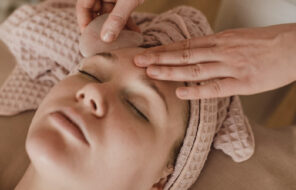- Also known as carbon dioxide therapy, carboxytherapy is a cosmetic treatment that implies using gaseous carbon dioxide to improve skin elasticity and treat cellulite, stretch marks, and dark under-eye circles.
- It’s a quick procedure with minor side effects, like bruising and swelling.
- One needs around 6-10 sessions for actual results, and a single session may cost $75-$200, depending on the area treated and the clinic.
Carboxytherapy is one of the most interesting cosmetic treatments you’ve ever heard of. It became popular as a resort procedure, while in the mainstream beauty world, it’s mostly done as a cellulite treatment.
Seeing videos of carboxytherapy treatments is quite strange. A nurse or doctor takes a needle and injects the skin with gas, which then makes the skin puff up from below. But what is the gas? And can such treatment really be beneficial? We’ll answer those questions, and more, in this guide to carboxytherapy.
In this article:
- What Is Carboxytherapy?
- What Skin Issues Does Carboxytherapy Target?
- Are There Any Side Effects to the Carboxytherapy Treatment?
- What Is the Process of Carboxytherapy Treatment?
- How Much Does Carboxytherapy Cost?
- How Many Carboxytherapy Treatments Will I Need?
What Is Carboxytherapy?
Carboxytherapy is a non-surgical cosmetic treatment for fine lines, cellulite, dark under-eye circles, and stretch marks that can be applied both on the face and body. As Dr. Denise Wong, a renowned, double board certified plastic surgeon at WAVE plastic surgery, tells Glowsly, carboxytherapy can also be called carbon dioxide therapy since CO2 is the gas at play.
“It was originally discovered in France in 1932 when accelerated wound healing resulted after bathing in CO2 enriched pool water,” Dr. Wong tells about the treatment’s origins.
As she puts it, the treatment involves the “therapeutic use of transcutaneous carbon dioxide.” Transcutaneous means that the CO2 is applied through the skin rather than topically. “It’s not currently approved by the FDA,” she adds, but despite that, it’s very popular in many countries as a minimally invasive aesthetic treatment. Despite looking pretty intense, she assures us that it’s minimally invasive.
The method of action is interesting, as well. “The infusion of carbon dioxide gas under the skin dilates blood vessels,” Dr. Wong tells us. “It increases blood circulation, promotes collagen stimulation, and improves skin elasticity and tone.“ This can have an impact on a wide range of skin issues, as we explain in the next section.
What Skin Issues Does Carboxytherapy Target?
The cool thing about carboxytherapy is that it can be done on any part of the body or face. Dr. Wong explains that it can be used “to reduce fatty deposits, cellulite, acne scars, fine lines and wrinkles, alopecia, and dark circles under the eyes.” In this section, we’ll discuss its effect on each of these in a little more detail.
Cellulite
Carboxytherapy is most frequently studied and recommended as a solution for cellulite. Cellulite is a complex dimpling skin that’s caused when fat tissue presses against the skin. The connective tissue of the skin is arranged vertically, which leads to the dimpled effect. Cellulite is also tied to other factors, including the condition of the skin and microcirculation, both of which are addressed by carboxytherapy.
By promoting microcirculation and boosting collage, carboxytherapy helps to fade the appearance of cellulite, as proven by multiple studies. It requires multiple sessions, and the results are not long-term, but it’s still impressive compared to many other suggested treatments.

Skin Elasticity
One of the major claims around carboxytherapy is its ability to firm up the skin. While clinical research on this effect has been pretty limited, Dr. Wong does mention a study that was done on humans (only 9 of them, unfortunately) that showed that carboxytherapy does seem to promote skin elasticity.
“The study by Oliveira et al. looked at the effects of carboxytherapy on skin laxity,” she explains. “It showed an increase in collagen and elastic fibers after one treatment session.”
However, the study didn’t include long-term follow-ups, and as we discuss later on, it seems that repeated sessions would be necessary to maintain such results. However, before a special event, it could be a nice way of firming up the skin.
Under-Eye Issues
Carboxytherapy can address a few of the issues that can impact the eye area, including fine lines, darkness, and loss of tone. When it comes to fine lines, it’s the same firming action that influences other types of wrinkles.
It can also reduce the severity of under-eye darkness. It addresses both the circulation issues that lead to the blue discoloration under the eyes and by boosting collagen improves skin thickness and firmness.
Stretch Marks
Stretch marks, also known as striae, are caused when the central layer of the skin (the dermis) stretches to the point of breaking, usually during times of growth or weight gain. By targeting that region of the skin, carboxytherapy is able to promote the fading of stretch marks.
Hair Loss
Carboxytherapy also presents an intriguing treatment for hair loss. It has been studied both for alopecia areata (an immune disorder that leads to hair loss) and androgenic alopecia (a.k.a. male-pattern baldness caused by hormones). In the case of hormonal hair loss, the results of one session eventually reverse themselves, but follow-up treatments can help prevent that from happening.
Scarring
Carboxytherapy can help with a wide range of scarring, including acne scars. It improves the scars in a similar manner to how it improves stretch marks and cellulite. Namely, it promotes a new, healthy formation of collagen, which helps to undo the indentation and damage. Studies have shown that carboxytherapy is moderately effective. It’s comparable to microneedling, although it’s not quite as powerful as a more intense laser treatment.
Are There Any Side Effects to the Carboxytherapy Treatment?
Carboxytherapy does have its side effects, but they’re fairly minor and quick to fade. Dr. Wong explains that certain side effects, like localized swelling, bruising, and mild discomfort are most common, but they only last for 1 to 5 days. Even with the mild side effects, those who undergo the procedure can go back to their normal life with almost no downtime.

What Is the Process of Carboxytherapy Treatment?
The good news about carboxytherapy is that it’s quick. A session only lasts about 15-30 minutes, according to Dr. Wong. It’s considered minimally invasive, but those who have undergone it still report that it can be quite painful.
Thankfully, a numbing cream can be applied beforehand to prevent some of that discomfort. “Patients may feel some pressure sensation as a small amount of CO2 is injected beneath the skin,” Dr. Wong explains.
How Much Does Carboxytherapy Cost?
A single session of carboxytherapy can cost as little as $75 and up to $200, depending on the clinic you choose and the size of the area you’d like treated. For example, a quick carboxytherapy treatment under the eyes will likely cost less than a cellulite treatment on the body. In most cases, however, it’s recommended to do multiple sessions for more long-term results, in which case, the final cost will be around $850-$1500.
How Many Carboxytherapy Treatments Will I Need?
This really depends on what your goal with carboxytherapy is. In general, most providers recommend between 6-10 sessions, depending on the specific concern and its severity.
“Results are temporary,” Dr. Wong adds. “Multiple weekly treatment sessions are initially recommended, with a follow-up treatment every 6 months for maintenance.”
In other words, carboxytherapy is not a long-term solution for any concerns, but if it’s within your budget, the regular treatments might be worthwhile.
Photos via @asliceopi, @sarashakeel





